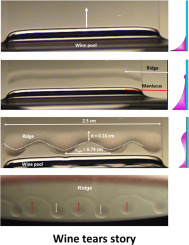Advances in Colloid and Interface Science ( IF 15.9 ) Pub Date : 2018-05-05 , DOI: 10.1016/j.cis.2018.05.001 Alex Nikolov , Darsh Wasan , Jongju Lee

|
For a long time, the phenomenon known as the “tears of wine” was believed to be due only to the surface tension gradient (e.g., the Thomson-Marangoni stress on the fluid/fluid surface's dynamics of wetting) and gravity. We experimentally demonstrated that the wine tear formation is not solely due to the surface tension gradient; instead, the ridge instability triggers the wine tears. Pouring wine into a glass causes a wine film to form on the glass. The film drains down under gravity and a ridge forms at its upper part. Over time, the ridge becomes unstable. Under gravity, a necklace of droplets (tears) appears and slides down. Here, we present experimental evidence that the Plateau-Rayleigh-Taylor theory for the stability criterion of a horizontal annulus fluid column under small, exponentially growing capillary disturbances and the surface tension breakdown into droplets can also be applied to the stability of a horizontal fluid's (wine) ridge on a wetted solid, where gravity causes the droplets (tears) to slide down, resulting in the formation of a necklace of droplets (“tears”). The wine droplets (“tears”) move down and up (“dance”) due to the effects of the surface tension gradient and gravity. The process repeats itself for a while. Over time, the wine components (e.g., organic acids and tannins) adhere on the glass. The glass surface becomes less hydrophilic and the wine wets the glass less. The wine film on the glass becomes unstable, the ridge does not form, and the tears stop appearing. The knowledge gained from the present study will enhance our understanding of the wetting and spreading dynamics of fluid mixtures on solids. It will also benefit our understanding of fundamental phenomena (such as wetting and spreading) and applied technologies (such as painting, printing, cooling, and cleaning), as well as aid in the development of robust devices (such as the lab on a chip).
中文翻译:

酒的眼泪:飞舞的水滴
长期以来,被认为是“酒的泪”的现象被认为仅是由于表面张力梯度(例如,流体/流体表面的润湿动力学上的Thomson-Marangoni应力)和重力引起的。我们通过实验证明了酒眼泪的形成不仅是由于表面张力梯度引起的,而且还在于酒眼泪的形成。相反,山脊的不稳定性触发了葡萄酒的眼泪。将酒倒入玻璃杯中会在玻璃杯上形成酒膜。薄膜在重力作用下流失,并在其上部形成隆起。随着时间的流逝,脊变得不稳定。在重力作用下,一条水滴(眼泪)项链出现并滑落。在这里,我们提供了实验证据,证明了在小空间条件下,水平环空液柱稳定性准则的高原-瑞利-泰勒理论 呈指数增长的毛细扰动和表面张力分解成液滴的现象也可用于润湿固体上水平流体(酒)脊的稳定性,在重力作用下,重力导致液滴(眼泪)向下滑动,从而形成项链水滴(“眼泪”)。由于表面张力梯度和重力的作用,酒滴(“泪”)会上下移动(“跳舞”)。该过程会重复一段时间。随着时间的流逝,葡萄酒成分(例如,由于表面张力梯度和重力的作用,酒滴(“泪”)会上下移动(“跳舞”)。该过程会重复一段时间。随着时间的流逝,葡萄酒成分(例如,由于表面张力梯度和重力的作用,酒滴(“泪”)会上下移动(“跳舞”)。该过程会重复一段时间。随着时间的流逝,葡萄酒成分(例如,有机酸和单宁)粘附在玻璃上。玻璃表面的亲水性降低了,酒对玻璃的润湿也减少了。玻璃上的酒膜变得不稳定,不形成隆起,并且不再出现眼泪。从本研究中获得的知识将增进我们对流体混合物在固体上的润湿和扩散动力学的理解。这也将有助于我们对基本现象(如润湿和扩散)和应用技术(如涂漆,印刷,冷却和清洁)的理解,并有助于开发健壮的设备(如芯片实验室) )。










































 京公网安备 11010802027423号
京公网安备 11010802027423号